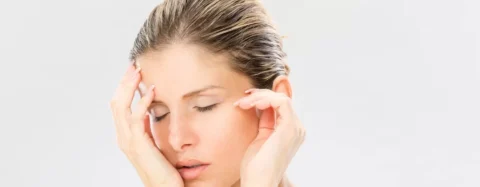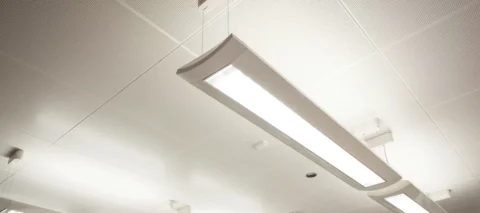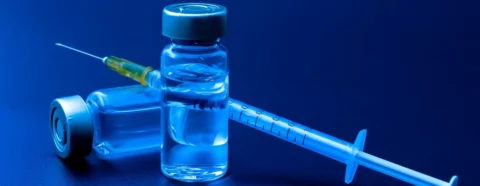Every day, people engage in activities that make the body exert energy and produce heat. Whether it’s strolling under the sun or doing a vigorous exercise routine, sweating is a normal bodily function to keep the body temperature constant at 37°C. However, there are cases where excess sweating can become uncomfortable and at times a hindrance to continue day-to-day activities. This condition is known as hyperhidrosis.
So how exactly can you get rid of the upper lip sweating? Fortunately, there are now several treatments such as oral medication, cream, and Botox injection that help regulate perspiration on the different parts of the face and body.
What Causes Upper Lip Sweating
The human body produces about a total of 2 to 4 million sweat glands that are commonly found in the palms of the hands, soles of the feet, armpits, and face. These glands are sensitive to the environment and extreme temperature changes, and they excrete water substances that are known as sweat or perspiration.
Facial hyperhidrosis is a common struggle for people and is often triggered by a variety of causes. To better understand what causes excessive sweat on the face, particularly on the upper lip, it’s important to first grasp the different types of hyperhidrosis:
1. Primary focal hyperhidrosis (PFH)
Primary focal hyperhidrosis is the most common kind of hyperhidrosis and occurs on specific focal parts of the body. It’s the reason why people experience sweaty armpits, clammy hands, or even facial sweating. This condition is often triggered by overactive sweat glands, causing the body to abnormally perspire.
This type usually begins to manifest in childhood or adolescence. Some studies have concluded that PFH may have a hereditary component, and members of the same family may experience this predicament.
In general, upper lip sweating is a form of craniofacial sweating (a type that affects the face and scalp area) that’s caused by primary hyperhidrosis. This type is also known to be the main reason for palmoplantar hyperhidrosis (sweating on the hands and feet) and axillary hyperhidrosis (excessive underarm sweating).
2. Secondary focal hyperhidrosis (SFH)
Secondary focal hyperhidrosis is also known as diaphoresis which is usually caused by a medical disease or condition. Though it’s a less common type of hyperhidrosis, many adult patients who have pre-existing illnesses such as diabetes, thyroid problems, low blood sugar, heart attack, or nervous system disorder can experience excessive sweating on various parts of the face and body.
3. Gustatory hyperhidrosis
There are occasional cases where sweating in the lip may also be triggered by intake of certain food. This is called gustatory sweating, typically happening on the face or neck when you eat spicy food or consume hot drinks.
This condition is also known as Frey’s syndrome and is mostly caused by a trauma to a parotid gland. Parotid glands are the body’s largest salivary glands and are located on each side of the face and in the external ear, responsible to aid in chewing and digesting food.
When the parotid glands are damaged, some nerves may lose their normal function or take time to regenerate which can cause a person to sweat on the mouth and lip area or experience facial flushing. And similar to secondary hyperhidrosis, gustatory sweating can also be a side effect of other existing illnesses that a person is already diagnosed with and can appear on the face, temples, forehead, and cheeks.
Treatments for Excessive Sweating
There are times when excessive sweating can be a sign of a serious medical condition, and a trip to the doctor may be necessary. It’s often recommended to seek immediate medical care if heavy perspiration is accompanied by lightheadedness, chest pain, or nausea. You should also observe if you’re sweating more than usual and night sweats become suddenly apparent.
But for the most part, many individuals who suffer from upper lip sweating may find readily available medical solutions and procedures to ease their situation. Most doctors may recommend the following treatments to remedy craniofacial hyperhidrosis:
1. Over-the-counter (OTC) and prescription antiperspirants
The usual treatment prescribed by dermatologists is the application of antiperspirants on the areas most affected by severe sweating. It’s a cheap and less invasive option that works by blocking sweat from escaping to the surface of the skin. Some people may confuse these with deodorants which are used to mask the smell that comes with excessive armpit sweating.
The recommended over-the-counter antiperspirants are those with a low dose of aluminum chloride or zirconium salt as its active ingredient. These salts dissolve into the skin and form temporary plugs in the pores to prevent sweat from exiting the body.
There are also prescription-only antiperspirants that usually contain 10 to 30 percent aluminum salts and work better than drugstore brands. They also have the aluminum chloride hexahydrate which is a stronger aluminum compound than what is found in most OTC brands.
Some notable clinical-strength antiperspirants are Xerac AC, Formalaz, Certain Dri, and Drysol. They are applied 2 to 3 nights in a row, usually before bedtime, and then followed by a once-a-week application to strengthen its effectiveness against sweating.
2. Prescription topical creams
Topical creams and lotions are also recommended for use in treating hyperhidrosis. Like antiperspirants, there are brands whose ingredients include aluminum chloride or aluminum chloride hexahydrate to control the body’s production of sweat. It’s also more ideal for use in the exposed parts of the body like the forehead, temples, neck, hands, and facial area.
For those who have sensitive skin or may have allergies when applying antiperspirant topical solutions, doctors advise the use of 1% topical hydrocortisone cream to help minimize irritation while maintaining the effectiveness of antiperspirants on the face and upper lip area.
3. Oral medication
The oral medications for hyperhidrosis are called anticholinergics, and they are a viable option for patients who sweat excessively in multiple locations. The most common anticholinergic substances are oxybutynin and glycopyrrolate. When they are both taken orally, they can block certain nerve impulses, particularly in the sweat glands, and effectively lessen the amount of sweat they produce.
It’s important to note that some of these medications come with risks such as dry mouth, blurry vision, and heart palpitations. While these drugs can offer relief to patients with intense facial and upper lip sweating, it’s best to schedule a doctor consultation first and claim a prescription note before taking any of them.
4. Endoscopic thoracic sympathectomy (ETS)
The technology today has also made it possible for surgeons to conduct elimination of sweat glands through surgical treatment. Endoscopic thoracic sympathectomy is a specialized type of surgery for primary focal hyperhidrosis and can help address extreme facial flushing.
The ETS procedure involves disconnecting of sympathetic nerves that control the sweat glands so they will no longer cause excessive sweating. It’s typically administered to relieve patients with palmar and axillary hyperhidrosis. It requires a small incision, usually in the armpit, to reach the nerves that lie inside the rib cage near the top of the chest.
ETS has seen a 95% efficacy rate in stopping sweating at the hands and about 85% in curing underarm sweat. People with craniofacial hyperhidrosis are advised to take this as a last resort as it’s an intensive treatment and carries minor side effects such as scarring, nerve damage, and compensatory sweating (also called reflex sweating and may appear on the lower legs, thigh, and back).
5. Botox

A minimally invasive treatment option for hyperhidrosis is Botox cosmetic injections. The Food and Drug Administration (FDA) has certified the use of botulinum toxin injections (a medication typically administered for cosmetic purposes such as anti-wrinkle injections and Botox lip flip) to address problems such as severe underarm sweating and excessive facial sweating.
Similar to lip flip surgeries, the botulinum toxin temporarily blocks chemical signals that are being transmitted from the nerves that control sweating. When sweat glands in the facial muscle are unable to read these neural signals, the body stops releasing excess sweat.
It’s advised that you get Botox injections from skilled practitioners to avoid potential complications and temporary side effects. When administered properly, the botulinum toxin injectable can improve a patient’s quality of life by showing at least an 82% to 87% decrease in sweat production with its effect lasting for 4 to 12 months.
All of these treatments are great options for relieving excessive sweating. But it’s important to know that some work best towards a particular type of hyperhidrosis. Here’s a table to summarize and give a clearer picture of how these solutions work:
| Recommended for | Usage and time to see results | How long does it last? | |
| Antiperspirants | Axillary (underarms) | Its suggested application is before bedtime to let the skin absorb it overnight. | They can last at least just 2 times of usage in a week. Some may prefer to use it regularly. |
| Topical creams | Palmoplantar and craniofacial (hands, feet, face) | Similar to antiperspirants | Regular use is recommended to manage daily sweating. |
| Oral medications | All types | Depends on the doctor’s recommendation | Depends on usage but it can effectively lessen the amount of sweat produced |
| Endoscopic thoracic sympathectomy | Axillary and palmoplantar | May take time to recover for 1 to 2 weeks | A study shows it can completely cure sweating with a minimal chance of recurring overtime. |
| Botox | All types | 2 weeks to see full effect | 4 to 12 months |
Botox for Upper Lip Sweating
Botox injections are widely used for cosmetic purposes such as reduction of facial wrinkles and forehead lines and adding volume to achieve plumper and fuller lips. It can also be used to combat the effects of aging and give patients a younger and fresher facial appearance.
Dermatologists consider botulinum toxin as a safe solution to removing the discomfort brought by excessive sweating. It treats hyperhidrosis in the same way that it does for lip flip patients whereas the botulinum toxin is injected in the lip area to cancel out the neural signals that cause the sweat glands to activate.
What to Expect From the Procedure
Only licensed medical professionals are certified by the FDA to use botulinum toxin, so it’s important to sign up for a trusted clinic to ensure the procedure goes well.
Small amounts of botulinum toxin are injected beneath the targeted area in the skin. Before inserting the needle, doctors may apply ice or local anesthesia to ease pain and avoid discomfort after the procedure. These treatments are usually over within 10 to 20 minutes, and patients can almost immediately resume their daily activities after the treatment.
General aftercare after getting a Botox includes avoiding strenuous exercises, avoiding too much pouting of the lips, refraining from touching or massaging the injection site, and taking only lukewarm showers to prevent swelling of the lip.
Botox procedures usually pose minor side effects which include headache, numbness in the injected area, swelling, bruising, or redness. When the procedure is done by an expert, serious side effects are rare and almost never happen. Patients may start feeling reduced sweating just 5 days after the treatment, with full results after 2 weeks.
Having a Botox injection is the best hyperhidrosis treatment for relief in the upper lip. However, its effects are only temporary, and follow-up visits to the clinic may be necessary if you wish to maintain the results. A Botox treatment requires repeated injections every few months to guarantee long-term comfort from perspiration.
Try Ethos Spa’s Botox Treatment for Upper Lip Sweating
Excessive sweating doesn’t only hinder people from doing their everyday activities but can also trigger feelings of social awkwardness and anxiety when left unmanaged. And while there are quick fixes like antiperspirants, topical creams, and medications to help reduce sweating, Botox treatment presents a better alternative with its long-lasting results.
Finding the best clinic is the first step to managing hyperhidrosis. At Ethos Aesthetics + Wellness, our group of board-certified doctors and skin experts guarantee you a safe Botox procedure so you can enjoy life without the discomfort from too much sweating.
We have also serviced numerous patients with our various lip enhancement treatments like Botox Injections, dermal filler, facial filler, and more. Book an appointment now to learn about our services and know how you can get started on your Botox journey.







